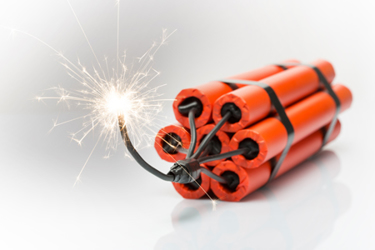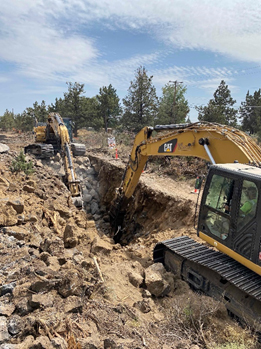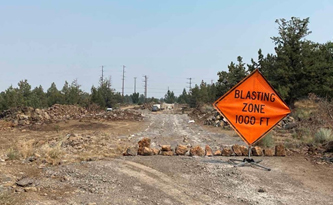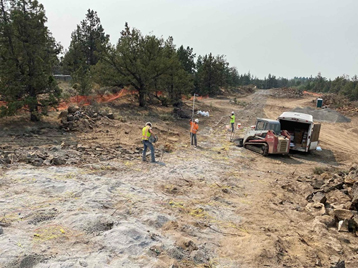The Contractor's Song: Building Pipelines In Rock!
By Jeremy Holland

’Cause I’m T.N.T. I’m dynamite / T.N.T. and I’ll win the fight / T.N.T. I’m a power load / T.N.T. watch me explode!
-AC/DC
This month our topic fits in well with a whole genre of music and it was hard to pick just one song to weave into this column, so I didn’t. The hits just kept coming to mind so consider this discussion of building pipelines in rock to be an homage to all things rock and roll! The only actual lyrics that I used, I can’t take credit for either, as one of our project managers, Antonio Chaj, developed a safety video for our team doing rock excavation on our pipeline project in Bend, Oregon, and used AC/DC’s “T.N.T.” as his background music, completely appropriate! So, without further delay, let’s dig into the discussion of installing pipelines in rock.
The Ties That Bind (Bruce Springsteen)
Before I talk about the ins and outs of trenching in rock, it's important to talk about the pipes that will go into those trenches. We need pipelines to supply water for drinking, irrigating, fire protection, and manufacturing. We need pipes to convey our wastewater away to be cleaned and returned to water ways so that we can use that water again. Because all potable water pipelines are pressurized, they tend to be shallower and as a result, much less challenging to install. It is the wastewater interceptors that tend to flow by gravity and can get deep where rock excavation of trenches is most challenging.

We need to build a trench for our pipelines, and we understand from geotechnical investigations that we are going to encounter rock in the trench. What is the best way to excavate that trench? In addition to the geotechnical report and recommendations, we need to consider how much rock needs to be excavated, how deep the pipe will need to be, and location of structures or other infrastructure that the pipe will be passing near or under. These can all drive the technique for excavating. We could use ripping teeth on an excavator, hand or machine mounted hydraulic hammers, tunneling machines equipped with rock cutting heads, or controlled blasting. And in some cases, a combination of methods may be needed to complete the trench. The key is to fully understand the conditions and have the expertise available to make the right choice, and carefully plan the work.

Continuing the discussion about planning, don’t let the lighthearted song title fool you. Safety is the most important consideration when we plan our work on all projects. Safety is always the top priority, but the stakes are raised when the work involves explosives and the associated release of tremendous amounts of energy. Our Integrated Work Plan (IWP) for blasting is extensive in spelling out a whole variety of parameters: specific location of the blast, the number, depth and spacing of blast holes, the explosives that will be used, a test blast plan, communication protocols during blasting, emergency equipment on site during the blast, underground utility locates in the area, and finally, the blast experts that sign off on the plan. The blast itself is almost instantaneous, but the amount of preparation to ensure it goes off without a hitch is extensive and absolutely necessary.
Rock This Town (The Stray Cats)
When blasting must occur near structures, there must be further consideration to protect those structures from damage. Sure, there will be noise, but the vibrations are what cause damage. The first step to protect structures is to complete a pre-blast inspection to understand existing conditions. Next, depending on how close a structure is to the blast zone, vibration monitoring equipment must be installed. This equipment verifies that an acceptable level of vibration occurred. Finally, post-blast inspection is completed to check that all potentially impacted structures are in original condition.

As it stands today, we need pipelines to convey water to and from our homes and businesses. Installing those pipelines are what we do as contractors of water infrastructure. How we get that work done and the various conditions we deal with are the meat of our efforts. Excavating in rock is just one more consideration that must be added to the overall planning that goes into each and every one of our projects. So, for those about to rock (excavate), we solute you!
 Jeremy Holland is a Market Executive in the Water Infrastructure Market in Mortenson Seattle’s Operating Group. With 23 years of engineering experience, Jeremy has served as project principal, technical advisor, project manager, and design engineer. His industry knowledge spans a wide variety of projects, clients, disciplines, and engineering problems. A licensed Professional Engineer in Oregon, WA, and Puerto Rico, Jeremy received a Bachelor of Science in Chemical Engineering and a Bachelor of Arts in English from the University of Notre Dame, and a master’s degree in Business Administration from Portland State University. He is a board member of the Oregon Association of Clean Water Agencies and is the Co-Chair of the Water Quality Committee.
Jeremy Holland is a Market Executive in the Water Infrastructure Market in Mortenson Seattle’s Operating Group. With 23 years of engineering experience, Jeremy has served as project principal, technical advisor, project manager, and design engineer. His industry knowledge spans a wide variety of projects, clients, disciplines, and engineering problems. A licensed Professional Engineer in Oregon, WA, and Puerto Rico, Jeremy received a Bachelor of Science in Chemical Engineering and a Bachelor of Arts in English from the University of Notre Dame, and a master’s degree in Business Administration from Portland State University. He is a board member of the Oregon Association of Clean Water Agencies and is the Co-Chair of the Water Quality Committee.
